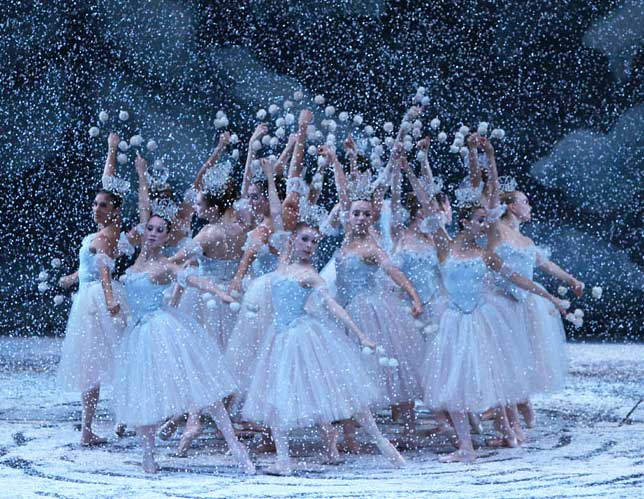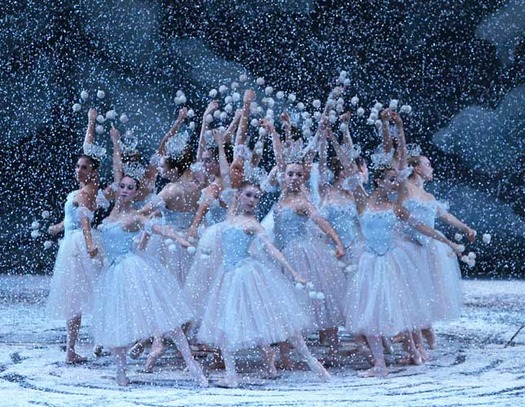
December 22, 2016
And May All Your Christmases Be Carefully Staged So As To Appear White

The Nutcracker at The New York City Ballet, choreography by George Balanchine, scenic design by Rouben Ter-Arutunian. Photograph by Paul Kolnik.
A few years ago, I was invited to a fundraising dinner for the New York City Ballet. Sitting next to me was a young woman who was a ballerina. I hardly know anything about ballet, so I was a little ill-equipped to hold up my end of the conversation. Because it was the Christmas season, and because it was one of the few NYCB performances I’ve seen more than once, I reverted to the obvious: “Do you get tired of dancing in The Nutcracker?”
My new friend was very gracious and said of course not. Yet The Nutcracker is to City Ballet what “Stairway to Heaven” was to Led Zeppelin. They’ve done it a million times, but it’s the thing that everyone comes to see. It can’t be easy. Is there anything harder than faithfully creating magic, night after night after night?
The legendary choreographer George Balanchine first danced the role of the Prince in The Nutcracker in his native Russia at the age of 15. Over forty years later, after founding New York City Ballet, he created his own version of the dance to Tchaikovsky’s familar music. With its debut in 1954, The Nutcracker was an immediate crowd pleaser, due in no small part to the beautiful sets and effects Balachine concocted with scenic designer Rouben Ter-Arutunian. Today NYCB performs it almost 50 times a year.
My favorite part occurs at the end of the first act, during the Waltz of the Snowflakes. As they begin their dance, snow begins to fall on the stage of the New York State Theater at Lincoln Center, first a few flakes, then more, then a virtual blizzard. The dancers create dizzying patterns on the stage as their feet cut through the mounting drifts. The effect is breathtaking and, yes, magical. I’d like to think that I’ve become sophisticated after years of design practice, but I must say this staged snowstorm effects me as if I were a nine-year-old.
And, like a nine-year-old, I asked my new friend the ballerina the obvious question: “What’s the snow made out of?” She had heard this one before, I guess. She told me it was made of paper, little pieces of white confetti. About 50 pounds of confetti a night, as it turns out.
I asked if it were slippery and she looked at me as if I were, well, nine years old. “It’s not real snow, you know,” she said, rather slowly. “Like I said, it’s paper.“
So, I said, it wasn’t hard to dance on. She shook her head. No, slippery wasn’t the problem. “It’s more that it gets…everywhere.” She laughed. “It gets in your eyes. It gets in your nose. When you get home you have to comb it out of your hair. When you take a shower you have to scrape it off the drain. It can really drive you crazy. You never escape it.”
She leaned in, as if she was about to make a secret confession. “Sometimes, even in April, or May, or even June, I’ll be going through one of my sock drawers and I’ll find one of those…little…pieces…of…paper. When that happens, I almost want to scream.“
I’ve often complained how no one appreciates what designers do, how hard they work to achieve effects that the world takes for granted, if they even notice at all. Yet I realized then, and remember now — every time I see The Nutcracker — how happy I am to have someone else work the magic for me every once in a while. I still enjoy the snowstorm. But I wish I were nine years old again.
This essay was originally published on Christmas Eve, 2004.
Observed
View all
Observed
By Michael Bierut
Related Posts

Business
Courtney L. McCluney, PhD|Essays
Rest as reparations: reimagining how we invest in Black women entrepreneurs

Design Impact
Seher Anand|Essays
Food branding without borders: chai, culture, and the politics of packaging

Graphic Design
Sarah Gephart|Essays
A new alphabet for a shared lived experience

Arts + Culture
Nila Rezaei|Essays
“Dear mother, I made us a seat”: a Mother’s Day tribute to the women of Iran
Recent Posts
Candace Parker & Michael C. Bush on Purpose, Leadership and Meeting the MomentCourtney L. McCluney, PhD|Essays
Rest as reparations: reimagining how we invest in Black women entrepreneurs Food branding without borders: chai, culture, and the politics of packaging Why scaling back on equity is more than risky — it’s economically irresponsibleRelated Posts

Business
Courtney L. McCluney, PhD|Essays
Rest as reparations: reimagining how we invest in Black women entrepreneurs

Design Impact
Seher Anand|Essays
Food branding without borders: chai, culture, and the politics of packaging

Graphic Design
Sarah Gephart|Essays
A new alphabet for a shared lived experience

Arts + Culture
Nila Rezaei|Essays
